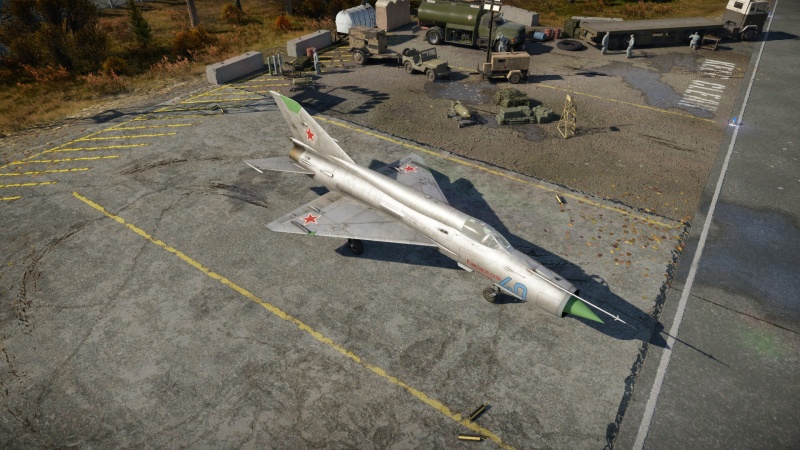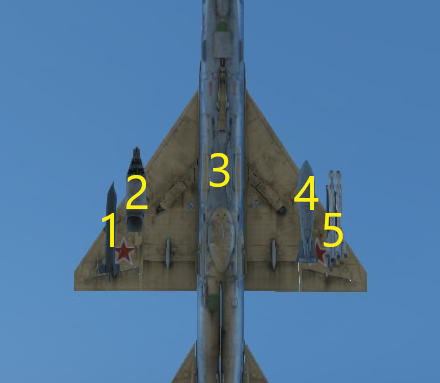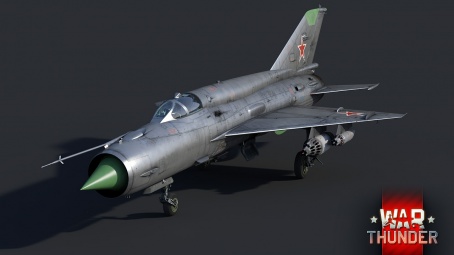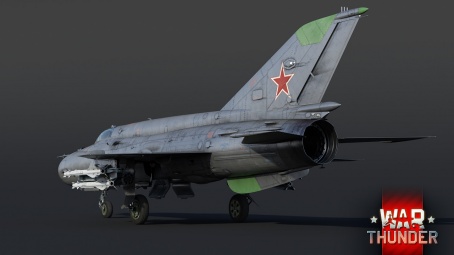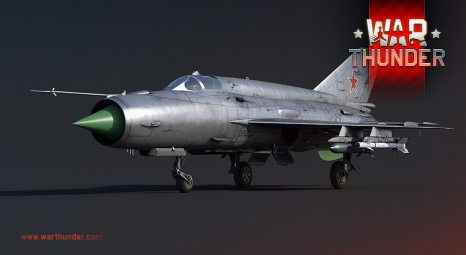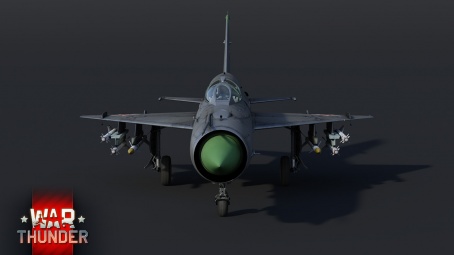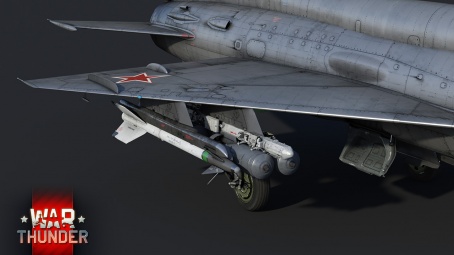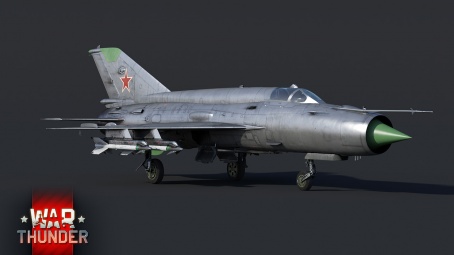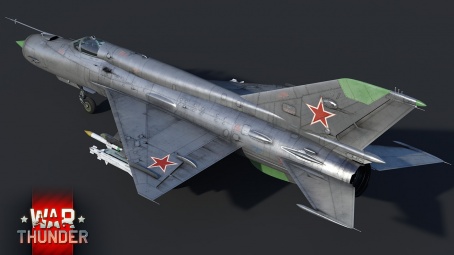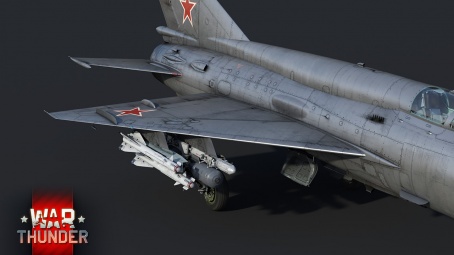MiG-21bis
| This page is about the Soviet jet fighter MiG-21bis. For other versions, see MiG-21 (Family). |
Contents
Description
In 1972, in parallel to the MiG-21SMT and ST variants, a full overhaul of the MiG-21 airframe was being developed around the new Tumansky R-25 engine, which promised a thrust-to-weight ratio of over 1 on full second-stage afterburner when mated to a lightened MiG-21 airframe. The resulting design was given updated avionics and other modernizations, before entering service as the MiG-21bis, the ultimate culmination of the third-generation Fishbed. The MiG-21bis was quickly adopted in the USSR by both the PVO and the VVS, with one minor difference for the two operators. The PVO-flown MiG-21bis was fitted with a Lazur-M GCI (Ground Controlled Interception) guidance system, whereas the VVS-operated variant had a Polyot-OI instrument landing and guidance system outfitted, with the only visual difference between the two variants being a single small antenna under the forward fuselage. The two variants in export were respectively designated as the MiG-21bis Lazur-M (Fishbed-L) and the MiG-21bis-SAU (Fishbed-N) to differentiate them.
Introduced in Update "New Power", the MiG-21bis is the ultimate Soviet development of the MiG-21. It looks roughly the same as the MiG-21S and MiG-21MF, both being third-generation MiG-21 models with search radars, internal GSh-23 cannons, and pronounced fuselage spines. However, the similarities end there, as under the hood, the MiG-21bis is a completely new beast. The most important upgrades are the new addition of the new R-25-300 engine, giving this aircraft increased thrust over its older variants. The other major upgrade to the MiG-21bis is its fire control system, which now allows it to not only use the R-13M1 missile, but also the ability to mount the APU-60-2 pylons which can carry twice as many R-60Ms on one hardpoint. All in all, people who enjoyed previous Fishbeds for their incredible dogfight performance, and built upon the mastery of working around both the disadvantages and advantages of the Fishbed airframes, will find this aircraft to be very enjoyable to fly, as what it lacks in BVR and strong missiles at its battle rating, are easily outweighed by the lightened airframe and relatively powerful engine allowing it to punish most planes that engage it in unconditional close-range dogfighting at low altitude, bar some specific planes.
General info
Flight performance
The MiG-21bis has above-average acceleration and high-speed performance. Firstly, the aircraft is quite fast, being able to reach 1365 km/h IAS on the deck (at low altitudes) before its wings rip, this translates to above-average level-flight speeds at medium to high altitudes. However, like all other MiG-21s, the MiG-21bis, whilst being able to turn well, it tends to bleed speed at an alarming rate during turns. Extended dogfights should therefore be avoided unless you are absolutely sure you are able to outturn your opponent, as the MiG-21bis will often end up on the losing side.
| Characteristics | Max Speed (km/h at 13,000 m) |
Max altitude (metres) |
Turn time (seconds) |
Rate of climb (metres/second) |
Take-off run (metres) | |||
|---|---|---|---|---|---|---|---|---|
| AB | RB | AB | RB | AB | RB | |||
| Stock | 2,177 | 2,142 | 16000 | 37.8 | 38.8 | 191.0 | 179.8 | 750 |
| Upgraded | 2,305 | 2,240 | 36.4 | 37.0 | 262.7 | 225.0 | ||
Details
| Features | |||||
|---|---|---|---|---|---|
| Combat flaps | Take-off flaps | Landing flaps | Air brakes | Arrestor gear | Drogue chute |
| X | ✓ | ✓ | ✓ | X | ✓ |
| Limits | ||||||
|---|---|---|---|---|---|---|
| Wings (km/h) | Gear (km/h) | Flaps (km/h) | Max Static G | |||
| Combat | Take-off | Landing | + | - | ||
| 1365 | 700 | N/A | 500 | 450 | ~12 | ~6 |
| Optimal velocities (km/h) | |||
|---|---|---|---|
| Ailerons | Rudder | Elevators | Radiator |
| < 650 | < 600 | < 950 | N/A |
Engine performance
| Engine | Aircraft mass | ||||||
|---|---|---|---|---|---|---|---|
| Engine name | Number | Basic mass | Wing loading (full fuel) | ||||
| Tumansky R-25-300 | 1 | 6,132 kg | 371 kg/m2 | ||||
| Engine characteristics | Mass with fuel (no weapons load) | Max Takeoff Weight | |||||
| Weight (each) | Type | 10m fuel | 20m fuel | 30m fuel | 34m fuel | ||
| 1,140 kg | Afterburning axial-flow turbojet | 6,852 kg | 7,532 kg | 8,232 kg | 8,532 kg | 10,000 kg | |
| Maximum engine thrust @ 0 m (RB/SB) | Thrust to weight ratio @ 0 m (WEP) | ||||||
| Condition | 100% | WEP | 10m fuel | 20m fuel | 30m fuel | 34m fuel | MTOW |
| Stationary | 4,040 kgf | 7,344 kgf | 1.07 | 0.98 | 0.89 | 0.86 | 0.73 |
| Optimal | 4,040 kgf (0 km/h) |
9,068 kgf (1,200 km/h) |
1.32 | 1.20 | 1.10 | 1.06 | 0.91 |
Survivability and armour
- 60 mm bulletproof glass - armoured windscreen
- 10 mm steel - bulkhead behind pilot
- Engine and fuel tanks take up most of the fuselage area behind the cockpit
Modifications and economy
Armaments
| Ballistic Computer | |||
|---|---|---|---|
| CCIP (Guns) | CCIP (Rockets) | CCIP (Bombs) | CCRP (Bombs) |
| |
|
|
|
Offensive armament
The MiG-21bis is armed with:
- 1 x 23 mm GSh-23L cannon, belly-mounted (250 rpg)
- 64 x countermeasures
The 23 mm GSh-23L are adequate cannons, firing at a high rate of fire. However, the individual rounds from the cannons have a low stopping power, necessitating many hits on target to destroy them.
Suspended armament
The MiG-21bis can be outfitted with the following ordnance:
| 1 | 2 | 3 | 4 | 5 | ||
|---|---|---|---|---|---|---|
| 100 kg OFAB-100 bombs | 4 | 4 | ||||
| 250 kg FAB-250M-62 bombs | 1 | 1 | ||||
| 500 kg FAB-500M-62 bombs | 1 | 1 | ||||
| ZB-500 incendiary bombs | 1 | 1 | ||||
| S-5K rockets | 16 | 16, 32 | 16, 32 | 16 | ||
| S-24 rockets | 1 | 1 | 1 | 1 | ||
| R-3R missiles | 1 | 1 | 1 | 1 | ||
| R-3S missiles | 1 | 1 | 1 | 1 | ||
| R-13M1 missiles | 1 | 1 | 1 | 1 | ||
| R-60M missiles | 1, 2 | 1 | 1 | 1, 2 | ||
| 490 l drop tanks | 1 | 1 | 1 | |||
| Maximum permissible weight imbalance: 570 kg | ||||||
| Default weapon presets | |
|---|---|
| |
Usage in battles
The main things to remember about this plane is that it is fairly manoeuvrable at high speeds and it accelerates quickly and climbs pretty well. In a combat situation, you should avoid flying slower than 800 km/h, as your plane loses a significant amount of thrust and manoeuvrability at speeds lower than that.
Here's how you would want to use this plane to its advantages depending of the state of the game you're in:
At the beginning, climb at a low angle (around 5-10 degrees) and watch your radar for any enemies flying high, it is recommended you stay at lower altitudes and keep a relatively high speed (between 900 to 1300 km/h) so that you can turn away from an enemy locking you with their radar/shooting a missile at you. If the enemy you have located is isolated/not paying attention, engage it and use either your missiles or gun to engage it. Try not to lose too much speed as your plane relies on it. don't forget to look around for any incoming threat.
Towards the mid or end-game, keep flying fast and avoid wasting speed in turns. Use Boom-N-Run tactics (fly towards a target at high speed, engage them quickly and run away) and assist the team with any problematic enemies. If you find a lonely target you can dogfight with, go for it as long as you don't have any other enemy nearby, as extended dogfights with the MiG-21bis tend to leave it very vulnerable to enemy fire.
In summary: the MiG-21bis is best used in Boom-N-Run tactics for most of the game unless your target is not very manoeuvrable, then you can turnfight with them.
Since your main missiles will usually be R-60Ms, try to fire them relatively close to the enemy (between 2 km to 0.5 km). If you're engaging a target flying at high speeds, the minimum distance of engagement will be < 2 kilometres, if your enemy is farther/flying away, try using R-13M1s instead.
Enemies to beware of:
- F-16A early (Block 10): Amongst the highest BR enemy you can fight if you're in a maximum downtier. This plane is your absolute nemesis as it can counter you in every way. It flies faster than you, it turns better than you and climbs better than you. If you spot an F-16A Block 10, your best strategy would be to try to destroy it from a surprise angle or team up on it with your teammates to destroy it. If you find yourself being targeted by an F-16A Block 10, try to stay fast and do short periodical vertical manoeuvres to throw its aim off. Don't forget to pre-flare if you're flying too slowly as its AIM-9L missiles can spell doom to you. Try to have teammates back you up in these situations, as it is unlikely you will be able to defeat a F-16A Block 10 in a 1v1 dogfight.
- F-14 (A Early/B): Another nemesis you can frequently encounter, but you can beat it. Its AIM-54 Phoenix missiles can destroy you at extreme ranges if you're not paying attention, if you find yourself in BVR range against a F-14, you can be easy prey to its AIM-7F missiles unless you counter them (either by flying very close to the ground or by notching and chaffing). When engaging in close-quarters fights against a F-14, one should take notice that the F-14 is rather manoeuvrable and can beat the MiG-21bis in a continuous turnfight. The best strategy against a F-14 is to make it lose its speed by doing burst climbs and re-descending upon it when it is at its slowest.
- F-4E: Whilst not being as nimble, a skilled F-4E player can easily destroy you. At BVR ranges, you are prey to the F-4E's radar missiles (as you would with any other enemy) but at close ranges, the F-4E can keep up with you in turns as long as it is flying at medium to high speeds (800-1200 km/h).It is possible to beat an F-4E in a sustained dogfight, just make sure you're alone to do it. Overall, the best strategy again an F-4E is, yet again, to bleed its speed with burst climbs and re-engage when it is at its slowest.
Radars
The MiG-21bis is equipped with a Sapphire-21 search and tracking radar. The radar is mounted in the nose of the aircraft.
| Sapphire-21 - Target Detection Radar | |||
|---|---|---|---|
| Maximum Detection Range |
Guaranteed Detection Range |
Max Azimuth Scan Angle |
Max Elevation Scan Angle |
| 30,000 m (theoretical) |
20,000 m | ±30° | -3°/+17° |
| Sapphire-21 - Target Tracking Radar | |||
| Maximum Tracking Range |
Minimum Tracking Range |
Azimuth Tracking Angle |
Elevation Tracking Angle |
| 20,000 m | 300 m | ±30° | ±17° |
Pros and cons
Pros:
- Impressive climb rate of 225 m/s, making this plane the second-best top-rank climber behind the F-104S and above the Phantom FGR.2 and FG.1
- Increased flight performance compared to earlier MiG-21s
- Excels against both aerial and ground targets
- Has access to flares that are fired downwards, which means that missiles can be more easily evaded
- Stunning acceleration
- Excellent energy retention
- Can wield six potent all-aspect R-60M air-to-air missiles
- Huge thrust to weight ratio
Cons:
- As all MiG-21s, it tends to bleed speed in turns, though not as much, thanks to the improved engine
- Vicious rudder lock at speeds above 700 km/h, can be frustrating when trying to get guns on target
- Pretty bad low speed manoeuvrability
- Doesn't respond well to wing damage - if a wingtip is lost, landing this plane will be very difficult, and if a wing is lost, the plane should be considered as lost
History
Devblog
By the late 1960's, the Soviet high command sought to increase the effectiveness of the MiG-21 jet fighter, especially at lower altitudes, while at the same time knowing that this could only be achieved by developing a more powerful engine for it. As a result, in 1971, the order to develop what would essentially become the MiG-21bis was issued by the Soviet high command.
As both the power plant manufacturer - Tumansky - as well as the MiG aircraft design bureau were already working on improvements, this order only officially recognized their work, and as a result, by 1972 the MiG-21bis was ready.
Unlike preceding variants, the MiG-21bis managed to strike a balance between performance and endurance. Additionally, the aircraft was fitted with an improved radar and a systems monitor, which made maintenance substantially easier. Furthermore, the maximum number of missiles the aircraft could carry was increased to six while it also received the option to carry the new R-13M air-to-air missile with increased range, higher G-loading and better seeker tracking over the preceding R-3S. Very manoeuvrable R-60M missiles can be carried as well.
The first MiG-21bis was constructed in 1972 and was adopted into service in the same year. Well over 2,200 units of the MiG-21bis would be manufactured, including licence-built versions. The MiG-21bis was one of the most widely produced variants of the aircraft and saw widespread use with numerous operators around the globe. In fact, some modernized modifications are still in combat use today.
Media
- Skins
- Images
- MiG-21bis Devblog Images
- Videos
See also
Links to the articles on the War Thunder Wiki that you think will be useful for the reader, for example:
- reference to the series of the aircraft;
- links to approximate analogues of other nations and research trees.
External links
- [Devblog] MiG-21bis: Ultimate Fishbed
- [skytamer.com] Mikoyan-Gurevich MiG-21bis "Fishbed-L" (Web Archive)
- [fas.org] MiG-21 FISHBED (Web Archive)
| Mikoyan-Gurevich Design Bureau (Микоя́н и Гуре́вич Опытное конструкторское бюро) | |
|---|---|
| Fighters | MiG-3-15 · MiG-3-15 (BK) · MiG-3-34 |
| I-225 | |
| Jet fighters | MiG-9 · MiG-9 (l) |
| MiG-15 · MiG-15bis · MiG-15bis ISH | |
| MiG-17 | |
| MiG-19PT | |
| MiG-21F-13 · MiG-21PFM · MiG-21S (R-13-300) · MiG-21SMT · MiG-21bis | |
| MiG-23M · MiG-23ML · MiG-23MLD | |
| MiG-27M · MiG-27K | |
| MiG-29 · MiG-29SMT | |
| Export/Licensed | ␗MiG-9 · ␗MiG-9 (l) |
| ◊MiG-15bis · ◔MiG-15bis · J-2* | |
| MiG-17AS · ◔MiG-17PF · J-4* · Shenyang F-5* | |
| ◊MiG-19S · J-6A* | |
| ◄MiG-21 SPS-K · ◊MiG-21MF · ◔MiG-21MF · ▄MiG-21bis · ◔MiG-21bis-SAU · ◊MiG-21bis-SAU · ◊MiG-21 "Lazur-M" · ▄MiG-21 Bison · J-7II** | |
| ◊MiG-23BN · ◊MiG-23MF · ◔MiG-23MF · ◊MiG-23MLA | |
| ◔MiG-29 · ◊MiG-29 · ◄MiG-29G | |
| *Licensed and domesticated with Chinese designations. | |
| **Unlicensed, reverse-engineered and domesticated with Chinese designations. | |
| See Also | Shenyang · Chengdu |
| USSR jet aircraft | |
|---|---|
| Bereznyak-Isayev | BI |
| Yakovlev | Yak-15 · Yak-15P · Yak-17 · Yak-23 · Yak-28B · Yak-30D · Yak-38 · Yak-38M · Yak-141 |
| Mikoyan-Gurevich | MiG-9 · MiG-9 (l) · MiG-15 · MiG-15bis · MiG-15bis ISH · MiG-17 · MiG-17AS · MiG-19PT |
| MiG-21F-13 · MiG-21PFM · MiG-21S (R-13-300) · MiG-21SMT · MiG-21bis | |
| MiG-23M · MiG-23ML · MiG-23MLD · MiG-27M · MiG-27K | |
| MiG-29 · MiG-29SMT | |
| Lavochkin | La-174 · La-15 · La-200 |
| Sukhoi | Su-9 · Su-11 |
| Su-7B · Su-7BKL · Su-7BMK · Su-17M2 · Su-17M4 · Su-22M3 | |
| Su-25 · Su-25BM · Su-25K · Su-25T · Su-25SM3 · Su-39 | |
| Su-27 · Su-27SM | |
| Ilyushin | IL-28 · IL-28Sh |
| Tupolev | Tu-14T |



